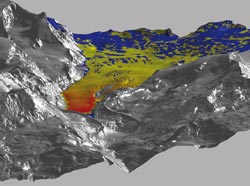Swiss Scientists measure glacial melting with light

The Findel glacier lit up, superimposed with changes in the thickness up to 2009. The colors green to red represent the loss of ice, blue shows increased thickness.<br>
Changes in the thickness of a glacier are traditionally measured by means of wooden poles and snow-shovels. Those methods are inexpensive and can be carried out to determine the annual or even seasonal result at individual locations.
It is, however, difficult to draw conclusions about changes in the thickness of an entire glacier or all the glaciers in the region merely on the basis of those positional measurements. The scientists now want to overcome that disadvantage of direct field measurement by applying laser technology.
Philip Jörg, a Ph.D candidate involved in this project, explains how it works: “A strongly bundled beam of light is shot from an aircraft and the time is measured that the light needs to reach the surface of the ice and bounce back to the aircraft. From this so-called “run time”, the distance from the plane to the glacier can be precisely determined to within just a few centimetres”. The laser data and the exact location and position of the aircraft give rise to a highly precise, three-dimensional picture of the glacier's surface.
49 million cubic metres of ice lost
Researchers at the University of Zurich carried out a corresponding campaign in October of this year with a high-resolution laser scanner at the Findel Glacier close to Zermatt. The surface model that was created was compared with the results of a first flight over the glacier in the year 2005 and now enables a conclusion on the changes in thickness and volume of the entire glacier. In those four years, the Findel Glacier has lost almost 3.5 metres of average ice thickness, and as much as 25 to 30 metres at its tongue. Overall, the glacier has lost around 49 million cubic metres of ice. If that volume of ice were melted and emptied into the Lake of Zurich, the water level of the lake would rise by about half a metre.
The next flight is planned for the forthcoming spring. The researchers anticipate new findings with regard to the spatial distribution of the winter snow coverage and its characteristics in terms of water content and reflectance. “While the politicians will be in Copenhagen in the next few days, debating a continuation of the Kyoto Protocol with specific climate targets, we are already working on the basic data of tomorrow”, says Michael Zemp, the head of the project and a glaciologist at the University of Zurich.
Cooperation partners:
The research project 'Laser Scanning Experiment Oberwallis' is being carried out jointly by the Glaciology and Remote Sensing units of the University of Zurich's Geographical Department. The project will continue until 2012 and is supported by the Swiss energy utility Axpo. The laserscanning flights are carried out in cooperation with BSF Swissphoto.
Contact:
Michael Zemp, Department of Geography, University of Zurich
Tel. 0041 44 635 51 39
E-Mail: michael.zemp@geo.uzh.ch
Media Contact
More Information:
http://www.uzh.chAll latest news from the category: Earth Sciences
Earth Sciences (also referred to as Geosciences), which deals with basic issues surrounding our planet, plays a vital role in the area of energy and raw materials supply.
Earth Sciences comprises subjects such as geology, geography, geological informatics, paleontology, mineralogy, petrography, crystallography, geophysics, geodesy, glaciology, cartography, photogrammetry, meteorology and seismology, early-warning systems, earthquake research and polar research.
Newest articles

Bringing bio-inspired robots to life
Nebraska researcher Eric Markvicka gets NSF CAREER Award to pursue manufacture of novel materials for soft robotics and stretchable electronics. Engineers are increasingly eager to develop robots that mimic the…

Bella moths use poison to attract mates
Scientists are closer to finding out how. Pyrrolizidine alkaloids are as bitter and toxic as they are hard to pronounce. They’re produced by several different types of plants and are…

AI tool creates ‘synthetic’ images of cells
…for enhanced microscopy analysis. Observing individual cells through microscopes can reveal a range of important cell biological phenomena that frequently play a role in human diseases, but the process of…





















